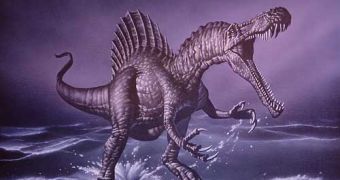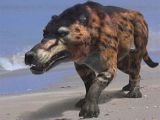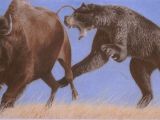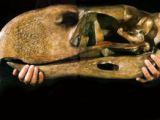When you think about something huge that has caused terror on earth, T-rex is perhaps the first thing that comes to your mind. It was popular before, and its image became extremely popular with the movie "Jurassic Park".
Indeed, a huge beast: up to 12.8 (42 ft) in length and 7.2 tonnes in weight. Bigger than an elephant! For 150 years, T-rex has been regarded as the giant of the carnivore dinosaurs. Then, in 1993, a longer carnivore dinosaur was found in Argentine: Giganotosaurus was up to 13.2 m (44 ft) long.
But the largest carnivore dinosaur (and land carnivore in general) ever to have existed was in fact Spinosaurus, whose remains were first discovered in 1910. It lived in nowadays North Africa during the Cretaceous Period, 95 to 93 million years ago.
Spinosaurus had specific "spines" on the back, long extensions of the vertebrae up to 2 m (6.6 ft) long and could have formed a sail-like structure or a hump. Spinosaurus reached a length of up to 18 m (59.1 ft) and was up to 9 tonnes (but the numbers are still disputed).
It had a much more slender body than the T-rex's and the head was more like that of a crocodile, fact that made some think this dinosaur was a fisher, while others believe it was a scavenger.
But today, we do not see dinosaurs dominating the ecosystems; the mammals are. And there is an order of specialized meat-eating mammals, Carnivora, comprising land carnivorous species: cats, dogs, weasels, bears, badgers, skunks and so on.
The largest species of Carnivora ever to have existed is a fossil bear that lived in North America 800,000 to 12,500 years ago: the Short-Faced Bear (Arctodus). Its closest living relative is the spectacled bear of the Andes.
Arctodus doubled a grizzly bear in size: it was 183 cm (6 ft) tall at the shoulder on all four legs, and raised up 3.35 m (11 ft) tall. It weighed up to 900 kg (2,000 pounds).
But the largest carnivorous mammal that ever existed was not related to modern Carnivora, but to the ... hoofed mammals. It looked like a hyena and it was the size of a rhino, but Andrewsarchus was a hoofed mammal closely related with the ancestors of the whales, dolphins, and hippos!
It terrorized the Mongolian plains 45-40 MA years ago, being 2 m (6.6 ft) tall and 5 m (17 ft) long. Just the skull was 1 m (3.3 ft) long! The weight was about 1 tone. Most researchers agree that the beast, rather than hunting, fed on corpses, and due to its huge size stole easily the prey from other predators, or chased away other scavengers from the corpses.
Today, the largest carnivorous mammal is the brown bear, more specifically the types from Alaska and Kamchatka: 680 kg (1,500 lb) in nature, and even more in captivity. This doubles the largest Siberian tiger (the biggest cat and tiger race). Polar bears too reach 600 kg (1320 lb).
South America stood isolated from the North for tens of millions of years, and as there were no competing carnivorous mammals, some huge predatory birds evolved there: the terror birds (which later entered North America), related to modern seriema birds.
These birds reached 2.8 m height, 400 kg. You can imagine their killing abilities, as they had the largest bird skull with impressive sharp pointed beaks: one dug in 2006 was as big as a horse one. The largest flying bird ever found, Argentavis magnificens (photo 5), lived 16-23 million years ago in South America.
They had a wingspan of 6.3 m (28 feet), almost as big as flying extinct pterosaurs that lived during the dinosaur era and had a wingspan of up to 12 m. These birds were related to condors and storks and more likely were scavengers. The bird was 3.5 m long and up to 100 kg heavy.
The Andean Condor is the largest meat eating bird: 108-122 in (274-310 cm) in wingspan and 24-33 lb (11-15 kg) heavy in the case of the males, but this bird is rather a scavenger.
The Steller's Sea Eagle, Haliaeetus pelagicus, from the shores of Eastern Siberia is the heaviest hunting bird in the world, weighing on average 6.8 to 9 kg (15 - 20 lb).

 14 DAY TRIAL //
14 DAY TRIAL // 


